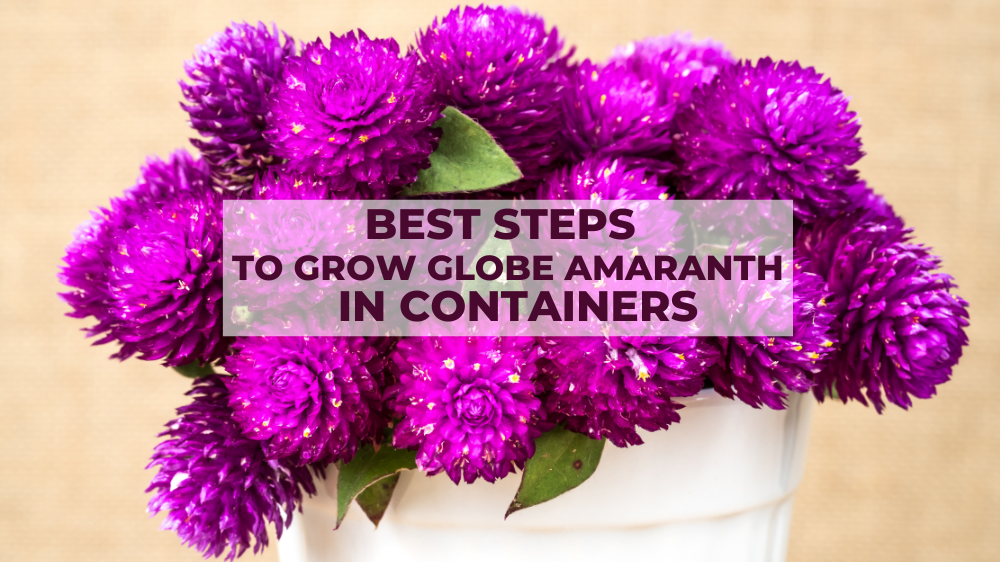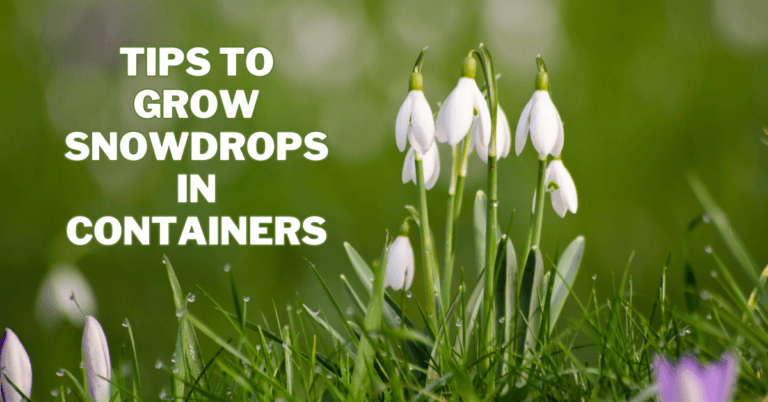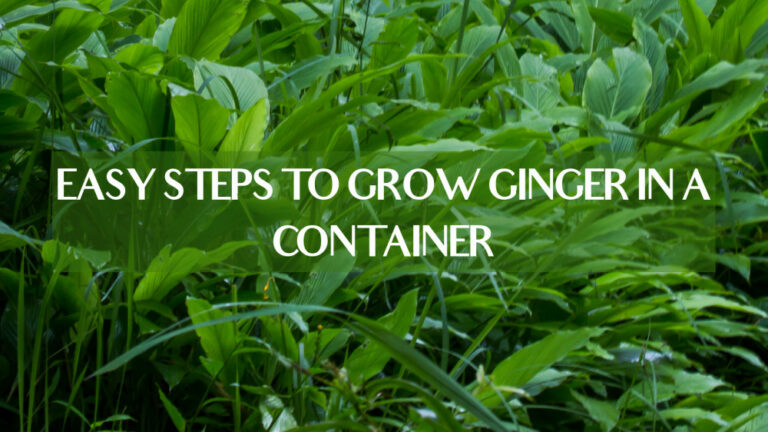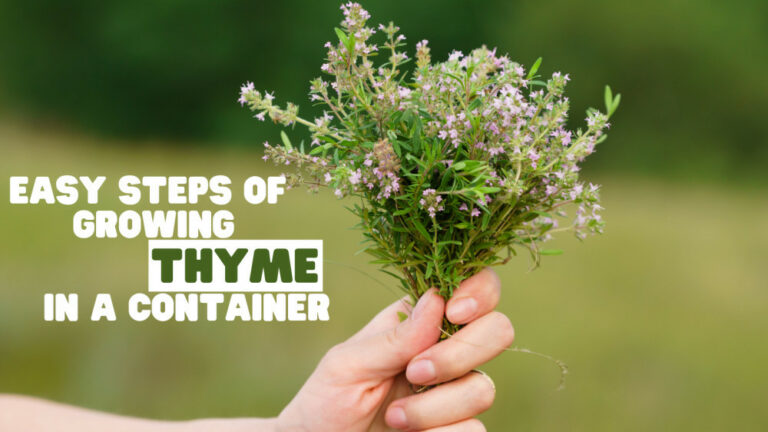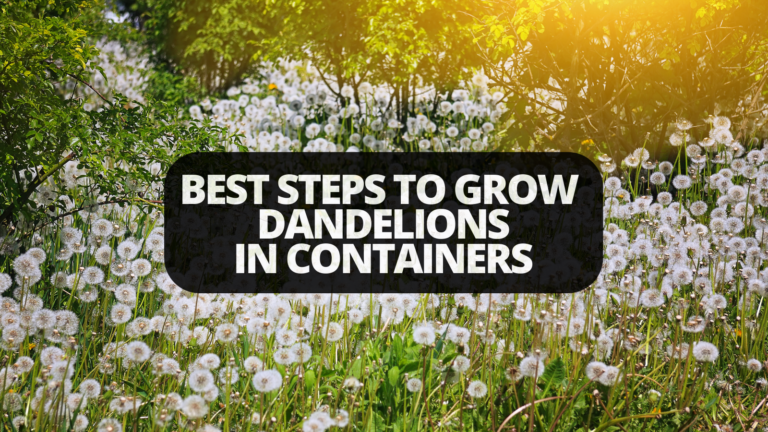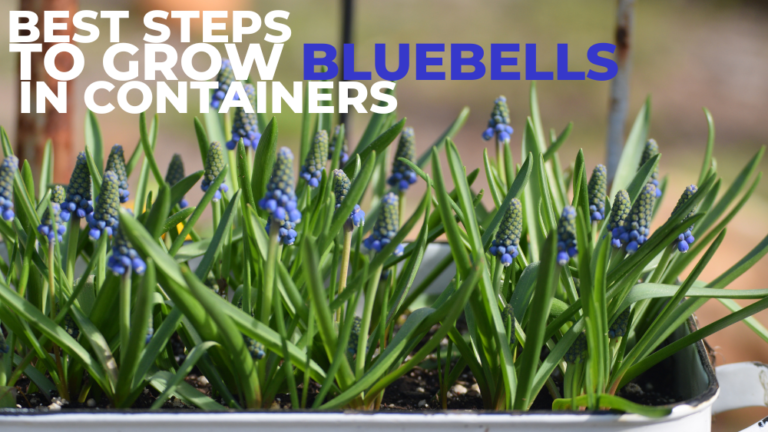Best Steps To Grow Globe Amaranth In Containers
Best Steps To Grow Globe Amaranth In Containers
There are various reasons to become familiar with this low-maintenance landscape plant if you aren't already.
Like most genuine annuals, Globe amaranth (Gomphrena globosa) is simple to grow and develops rather quickly.
It is a little plant with upward-growing stems that bloom for a long time, giving out bright bracts resembling clover and a wonderful magenta hue.
Because they remain so long, globe amaranth blooms are excellent for fresh flower arrangements.
Don't be shocked if the cut flowers have already begun to root in the vase when you discard your flower arrangements.
These plants are easy to grow. The blog will help you to grow globe amaranth in containers with ease.
History & Origin Of Globe Amaranth
The tropical regions of the Eastern and Western Hemispheres are home to the Gomphrena plant, commonly known as the globe amaranth.
It shares a kinship with the cockscomb and the Love-Lies-Bleeding plant. Although modern varieties are now available in purple, pink, and white in addition to magenta, the native plant had magenta, clover-like flowers. Since the 1700s, the plant has been planted in gardens across America.
Globe amaranth, of which there are three popular types, white, purple, and striped, are desired for their heads of blooms, which, if collected before they are too far gone, can preserve their beauty for several years, according to Joseph Breck in his 1851 book The Flower Garden.
The seed has trouble growing in the open ground; it is advised to soak it in milk for twelve hours; perhaps scalding would work better.
The ancients supposedly gave a plant with red and green leaves on the same stem named Gomphrena; this is most likely our Amaranthus Tricolor.
From seed, gomphrena is a little challenging to cultivate. The seeds should be sowed indoors in a bottom-heated container in February.
Put in a half-inch deep. Within less than 10 days, the seeds will begin to sprout when there is no longer a risk of frost, transplant outside.
Plants should be placed 4–6 inches apart. Most soil types will support the growth of Gomphrena.
However, they prefer loamy, compost-rich soil. The plants require direct sun. Flowering will begin in July and will last until the first deadly frost.
Types Of Globe Amaranth
You can plant various Gomphrena flowers in your garden for beautiful summer blossoms. Here are a few common types at nearby markets or online retailers.
To grow globe amaranth in containers perfectly, you should know the best home garden varieties.
1. Gomphrena Globosa
One of the most well-known flowers in the Amaranthaceae family is the Gomphrena Globosa.
Makhmali, Vadamalli, and Globe Amaranth are some of the plant's common names. The most distinctive aspect of the flower is its spherical inflorescences.
They are available in various vivid colours, including red, orange, white, pink, lilac, and magenta.
2. Gomphrena Haageana
The herbaceous perennial plant Gomphrena Haageana can function as an annual plant in temperate areas.
The popular name Button Flower knows the plant. The Strawberry Fields Globe Amaranth is a cultivar of the G. Haageana plant.
The plant gets its name from its brilliant red blossoms resembling strawberries. The plant can grow up to 20″ inches tall, making it one of the taller types.
This makes it the ideal flower for bulk production and arrangements.
3. Gomphrena Celosioides
The Celosia plant is similar to Gomphrena Celosioides. It is a perennial herb that is a member of the Amaranthaceae family.
Although the plant is South American in origin, it has naturalized throughout Asia, Australia, and Africa.
The Bachelor's Button is the name of the plant. The plant has many branches and is available as an annual or short-lived perennial.
Its elliptical leaves are hairy, and it has a thick taproot. The blooms have terminal spikes and are supported by woolly receptacles.
Their pink-to-white colouring complements rock gardens and other environments well. Ants typically disperse the extremely tiny seed.
4. Gomphrena Perennis
An herbaceous plant known as the Gomphrena Perennis is either an annual or a perennial plant.
Although it is primarily grown for decoration, certain areas employ leaves and blossoms in local cuisine. In addition, the plant is grown for cut flowers.
It can thrive in Mediterranean, tropical, subtropical, and temperate climates and is drought-resistant.
Because it grows well in Hardiness Zones 2 through 13, it may be grown almost everywhere. Start seeds, seedlings, and transplants can be used to cultivate the plant, which requires well-drained soil to thrive.
You must carefully control and maintain the plant because it can be invasive to keep it from suffocating nearby plants.
While the perennial can also be planted in the summer, it should be planted at the end of winter or spring.
5. Gomphrena Serrata
The Prostrate Globe Amaranth is another name for the Gomphrena Serrata. Although it originated in the Americas, the plant has become a native of India.
It is a perennial or annual herb. The plant's stems can be bent or prostrate, growing anywhere between 4 and 40 inches tall. It has very fibrous roots that are frequently utilized in food and medicine.
The stalkless leaves have an attractive green hue and are oblong to obovate. The flower heads' inflorescences are typically white.
However, they can occasionally contain red or pink tinges. They are shaped like small oblongs and feature thick hair.
The plant has toothed crests on its bracts. The plant blooms all year long, and the seeds are incredibly tiny.
6. Gomphrena Pulchella
The Gomphrena Pulchella has recently risen to the top of the plants sold at garden centers. Its three primary species are the Firework, Truffula Pink, and Proven Winters.
Due to its hot pink blooms that appear to have exploded with tiny yellow colour rays, Firework is much more well-known. It can quickly reach 4 feet and is primarily found in Bolivia.
They are incredibly hardy plants known to endure all types of weather, including drought and nonstop rain.
Similar to the Firework but about half as tall is the Truffula Pink. Both flowers are excellent pollinators, and they share the same vivid colour.
Grow Globe Amaranth In Containers
The most common way to plant globe amaranth is through low-cost nursery seedling packets. It is a low-maintenance flower that prefers a position with full sun and well-drained soil.
Without deadheading, globe amaranth will bloom profusely all season, but you'll undoubtedly want to add some enduring blooms to your vase, so sheer away.
Choose The Right Container
Pick a spot with excellent drainage and direct sunlight. Except in alkaline soil, globe amaranth plants may thrive anywhere.
Although they can be grown in pots, globe amaranth works best in garden soil. 12 to 18 inches between plants (31-46 cm.)
Large containers work well for both decorative kinds and plants raised for greens. Amaranth does better in a warm vegetable bed or border when grown for seed.
Soil To Grow Globe Amaranth In Containers
Use soil that drains appropriately for planting. You can be adaptable because globe amaranth tolerates organic and insufficiently fertile soils. They can flourish in loamy soils, clay, or regular garden soil.
You're set as long as it drains. Maintain a pH of 6-7. Although it can handle a tiny amount of alkaline (or bare) soil, this plant prefers slightly acidic soil.
Employ soil amendments like lime to improve the pH level. Acquiring the proper pH level is much easier because some soils are already premixed with a default value.
Each seed should be spaced 12 inches apart. Each seed should be sown around one centimetre deep.
The globe amaranth seeds don't require much soil to cover them. To ensure continuous blooms, give these sensitive annuals plenty of room to grow. Each plant should not exceed 12 inches in height.
Grow Globe Amaranth From Seeds
Growing globe amaranth from seed is possible, but it is better to sow the seeds inside in late winter for the earliest blooms. The plants need around eight weeks to mature from seed to blossom.
Because germination rates are low, sow many more seeds than you need. Using an electric heat mat may help you have better luck with germination.
Gathering seeds from globe amaranth flowers is simple, so don't worry about spending money to buy enough seeds for your flowerbed.
Watering
Hydrate the plant's base rather than the blossoms or leaves when watering. The soil is frequently kept damp but not flooded by water. Maintain your scheduled watering. Feel the soil's top several inches with your finger.
It should be damp but not dripping. In between waterings, keep it from drying out. Summertime watering should be increased to promote flowers.
Don't overwater, though, since this can lead to your new sprout damping off, which is brought on by a bacterium in the soil.
Ensure the container has numerous drainage holes if growing in one to remove extra water. Each week, use no more than 2 inches of water.
Consider the rains when planning your watering routine. Try to maintain a high level of humidity and atmospheric moisture. Since it is a tropical plant, it enjoys heat and heavy humidity.
Sunlight Requirements
In full sun to partial shade, globe amaranth thrives. Insufficient sunlight causes plants to become leggy as they search for the sun and decreases blossoming.
Temperature & Humidity
Globe amaranth can grow in almost any environment, but you shouldn't sow the seeds outside until the spring when the soil has warmed up.
Fertilizer
Although globe amaranth doesn't require fertilizer, it benefits from a dose of plant food to promote blooming.
Use organic fertilizer and search for an NPK of 14-14-14 or 12-12-12 if possible. Choose a low-nitrogen fertilizer for optimal results since nitrogen grows leaves rather than flowers.
Using a high-nitrogen fertilizer will assist your plant's weak or yellowing leaves in returning to a vibrant green.
A lot of leaves are produced when the plant is overfed. Use less fertilizer or eliminate them if you want more flowers.
Although it withers away in the cold, the seeds will produce another season's stunning, charming globes.
Propagation
Seeds can be used to grow plants. Slow germination might take anywhere between two and four weeks.
The germination rate is typically poor, meaning a significant portion of seeds may not sprout. 85 to 100 days are needed for maturity.
The deep taproot of this species should not be disturbed in any way. To extend the growing season, start seeds within eight weeks before the final typical spring frost date for both perennial and annual cultures.
Soak seeds overnight. Use cardboard egg cartons that may be divided for planting or biodegradable seed starter cells.
Try your best to scatter no more than four of the tiny seeds into each cell. They should have an eighth of an inch of potting material loosely covering them.
When the seedlings develop one to two sets of genuine leaves, thin them to one per cell. Before planting the seedlings outside, acclimatize them to the outdoors by leaving them outside for a few hours each day for three to five days after the threat of frost has passed.
After the threat of frost has gone, place the individual cells directly into the garden or large containers.
You can straight sow seeds in the garden for perennials, but it may take them a second year to mature and blossom.
Cultivation
Site with ordinary soil that drains nicely and whole light. Despite always having moisture, globe amaranth can tolerate dry periods.
The availability of transplants is restricted because the plant does not have much shelf appeal. However, you might discover them at your favorite garden center.
If you find transplants for sale, put them in your garden or larger containers, where they will swiftly grow into stunning flowering plants. Fortunately, globe amaranth is also quite simple to grow from seed.
It should be sown outdoors after any threat of frost or indoors 6 to 8 weeks before the anticipated last frost.
Cutting the flowers regularly will encourage compact, bushy growth and the production of more blossoms. Around the garden, globe amaranth seedlings may sprout.
The seedlings of globe amaranth may reseed in the garden and grow in later years. These are simple to remove and transplant to new locations if desired.
Of course, cutting the blossoms will lessen the possibility and quantity of possible volunteer seedlings.
Pruning and Maintenance
Cut off the first flower buds you see to help your plants grow more robustly. If unattended, you could get thinner plants instead of the fuller, bushier appearance many people love.
Certain plants might need to be staked or supported by a trellis if they are lanky. Deadheading flowers encourage additional blooms and prevent legginess.
Deadheading your globes may seem strange, but it encourages the growth of additional flowers during the growing season.
You can cut the stem where it meets the flower bud exactly there. This makes a clean-cut possible. Using sterilized pruners or scissors to lessen the chance of contracting bacteria or viruses.
Trim the first buds, and here and there, some blooms. The younger leaves are initially covered in thin white hairs during the flowering season, which lasts from June until October. The leaves grow alternately and are round.
Harvesting Globe Amaranth
The complete plant known as globe amaranth can be collected. Some folks consume the plant.
Although all of the plant's parts—roots, seeds, blossoms, and leaves—are SAID edible, some people only eat the seeds as a grain.
It's up to you whether you choose to consume it or not. Do your homework because eating world amaranth may cause responses in some people.
Despite being regarded as edible, the leaves and stems must first be boiled due to oxalic acid.
You can harvest it for a gorgeous centrepiece in addition to eating it. It can be placed in an arrangement within your home or dried for use in crafts.
The blossom's dye is also an excellent food dye for colouring beverages, teas, cakes, and other baked goods.
The roots can be consumed in soups and salads like any other vegetable. Consume them right away because they become limp very quickly. The flower heads can be picked up in the same manner as deadheading.
Use them how you see fit by pinching them at the base, where the globe joins the stem. Sprouts can also be picked and consumed as young plants.
You can add roots and seeds to soups, salads, drinks, and other dishes. When the globe opens up, the stems can be cut. The globe can be left there and used as a bouquet or decoration.
Additionally, some cultures utilize them as tea or dye. If you intend to eat it, do your homework. This plant could cause sensitivity in some people.
You might want to do your homework if you intend to eat it. This plant could cause sensitivity in some people.
Before using the plant in any recipe, it should be cleaned and rinsed.
Conclusion
The edible leaves can treat hypertension, and it is simple to pick the button-shaped flowers and preserve them for use as a tea to treat bronchial problems.
Globe amaranth has a wealth of anti-oxidants, anti-microbial, and cancer-fighting cytotoxins.
I trust you enjoyed this article on the Best Steps To Grow Globe Amaranth In Containers. Please stay tuned for more blog posts to come shortly. Take care!
JeannetteZ
>>>Please click here to read my all-inclusive article about Container Gardening<<<
>>>Are you interested in homegrown herbs and medicine? Please click here to find out more about it!<<<
Your Opinion Is Important To Me
Thoughts? Ideas? Questions? I would love to hear from you. Please leave me your questions, experience, and remarks about this article on the Best Steps To Grow Globe Amaranth In Containers in the comments section below. You can also reach me by email at Jeannette@Close-To-Nature.org.
Disclosure
This post may contain affiliate links. As an Amazon Associate and other affiliate programs, I earn from qualifying purchases at no extra cost to you. Read my full affiliate disclosure.
You might also enjoy these blog posts:
Best Steps To Grow Strawflowers In Containers
Best Steps To Grow Tansy In Containers
Best Steps To Grow Milkweed In Containers
Best Steps To Grow Bluebells In Containers
Best Steps To Grow Flax In Containers

